 |
Home | Charity | Feedback |
Denmark: Copenhagen
Copenhagen, Denmark: As colourful today as was its history by Prakash Bang, Editor in Chief 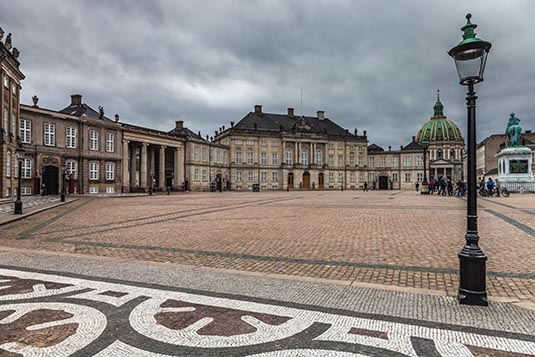 From Copenhagen's origin as a hamlet which hardly anyone had ever heard of to a position as the dazzling capital of the Danish Empire, and to its current position as one of the world's most talked about as well as sung of cities is a colourful history. Copenhagen is Scandinavia's largest city and its history goes way back. The reigning monarch Queen Margrethe II can trace her ancestry back to the Viking Age and that makes Denmark the world's oldest kingdom. Among cobbled squares, narrow streets and old buildings the history lives with us to this day. 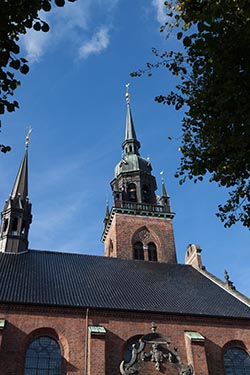 I was leading a group of 20 friends to Greenland. Copenhagen was our gateway city. Coming from different destinations we would all assemble at Scandic Palace Hotel located in the city centre. 14 of my friends reached from Iceland. Since I had already visited Iceland a few years ago, therefore, me and the other 5 friends went direct from India.
I was leading a group of 20 friends to Greenland. Copenhagen was our gateway city. Coming from different destinations we would all assemble at Scandic Palace Hotel located in the city centre. 14 of my friends reached from Iceland. Since I had already visited Iceland a few years ago, therefore, me and the other 5 friends went direct from India.
Summer had just ended and at this time of the year Greenland becomes accessible by flight only from Copenhagen. Now that we were there, it was prudent to spend a day to explore the highlights of this beautiful city. Really speaking one would need many days to really enjoy the many gems of Copenhagen, but that was not to be. For the 2 nights that we had on hand, Scandic Palace was the hotel of our choice. This 100-year old historic hotel overlooks Radhuspladsen (the City Hall Square) and is walking distance to all that a tourist would be looking for. By the time I reached the hotel, it was early afternoon. The rest of the group would come in by late evening. It therefore made sense to freshen up and walk the neighbourhood. Thankfully, the sun was out. The forecast for the next day was a bit gloomy! 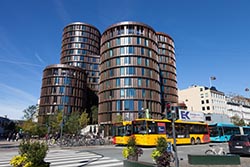 My first priority was to walk to the Central Railway Station to check for the train options to Stockholm in Sweden. The plan was to visit this neighbouring country on our return from Greenland. With tickets in the pocket, I commenced my walk.
My first priority was to walk to the Central Railway Station to check for the train options to Stockholm in Sweden. The plan was to visit this neighbouring country on our return from Greenland. With tickets in the pocket, I commenced my walk.
Across our hotel was the City Hall. It is the headquarters of the municipal council as well as the Lord Mayor of the Copenhagen Municipality. The building was built in the years 1892-1905. It was designed by the architect Martin Nyrop in the National Romantic style, drawing inspiration from the Siena City Hall, Italy. In recent years The City Hall has been used for scenes in Danish hit television series like "The Killing" and "Borgen". 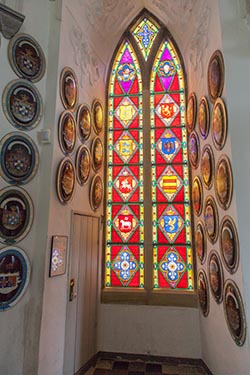 City Hall is - with its 106 meters to the top of the tower - one of the tallest buildings in Copenhagen, and offers a great view over the city. City Hall is an open building where you can come and go as you please during the opening hours, except from the tower where you'll need to be escorted by a guide.
City Hall is - with its 106 meters to the top of the tower - one of the tallest buildings in Copenhagen, and offers a great view over the city. City Hall is an open building where you can come and go as you please during the opening hours, except from the tower where you'll need to be escorted by a guide.
Right across the City Hall is Copenhagen's largest shopping area centered around Stroget. It is one of Europe's longest pedestrian streets with a wealth of shops, from budget-friendly chains to some of the world's most expensive brands. The stretch is 1.1 kilometers long and runs from City Hall Square to Kongens Nytorv. Stroget is a nickname from the 1800s and covers the streets Frederiksberggade, Nygade, Vimmelskaftet and Ostergade and Nytorv square, Gammeltorv Square and Amagertorv Square. Stroget is most famous for shopping. Big international brands like Prada, Max Mara, Louis Vuitton, Mulberry, Hermes and Boss are represented at the end of the street facing up to Kongens Nytorv. For the budget friendly, one can find shops like H&M, Vero Moda, Weekday and Zara. 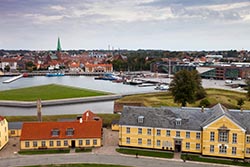 However, Stroget is not just for shopping. Look up and down the side streets during your shopping spree, and you will see several of Copenhagen's beautiful sights and attractions, such as Helligandskirken, Church of Our Lady Saviour where Crown Prince Frederik and Crown Princess Mary were married, the Gammeltorv Square, the court house at Nytorv Square and the Stork Fountain (Storkespringvandet) at Amagertorv Square from where one can see across the canal the Christiansborg Palace, where the parliament sits and the Stock Exchange Building with its famous 'twisted dragon' spire.
However, Stroget is not just for shopping. Look up and down the side streets during your shopping spree, and you will see several of Copenhagen's beautiful sights and attractions, such as Helligandskirken, Church of Our Lady Saviour where Crown Prince Frederik and Crown Princess Mary were married, the Gammeltorv Square, the court house at Nytorv Square and the Stork Fountain (Storkespringvandet) at Amagertorv Square from where one can see across the canal the Christiansborg Palace, where the parliament sits and the Stock Exchange Building with its famous 'twisted dragon' spire.
It was a good couple of hours of walk. By the time I was back at the hotel, the rest of the group had arrived. For dinner, everybody were on their own. Some opted for Indian cuisine, some for Danish and some for Oriental - to each his own! 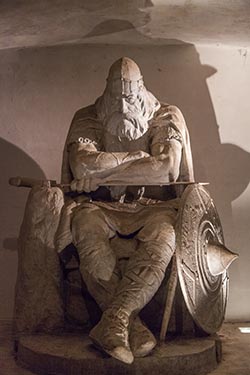 For the sight-seeing tour the next day, I had availed the services of Hamlet Tours. They had organized a comfortable bus for us with a learned guide who doubled up as the driver too.
For the sight-seeing tour the next day, I had availed the services of Hamlet Tours. They had organized a comfortable bus for us with a learned guide who doubled up as the driver too.
As scheduled, the bus was at our hotel gates at 9 AM. The group was ready to roll. The sumptuous breakfast did its trick. The plan for the day ran something like this: 9 AM, departure from the hotel, transportation to Helsingor 10-11.30, guided tour of Kronborg Castle 11.30-12.15, transportation to Hillerod 12.15-14.30, lunch and time to explore Frederiksborg Palace 14.30-15.15, transportation to Copenhagen, stop at Rosenborg Palace and King’s Garden 15.15-15.45, Amalienborg Palace Square and walk to Nyhavn 17.00, Canal Cruise and drop to the hotel thereafter When in a group it’s quite a challenge to adhere to time lines. Thankfully, we could cover all that was planned. Briefly about our explorations. 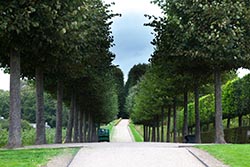 Helsingor was about an hour’s drive towards the coast. The village is home to Kronborg Castle.
Helsingor was about an hour’s drive towards the coast. The village is home to Kronborg Castle.
Kronborg Castle is probably the most famous Danish castle, known worldwide from Shakespeare's Hamlet. Towering on a promontory in Northern Zealand, Kronborg faces the sound between Elsinore and Helsingborg in Sweden. Grand fortifications with bastions and casemates used to protect the Danish land from unwanted visitors and was home to the royal family until the late 1600. A tour of the castle will take you through beautifully decorated rooms with renaissance and baroque interiors that reveal the residents’ decadent lifestyle. Among the main attractions is Frederik II’s fine ballroom and the statue of Ogier the Dane, a mythical national hero that has been sitting in the cold casemates below the castle for hundreds of years. 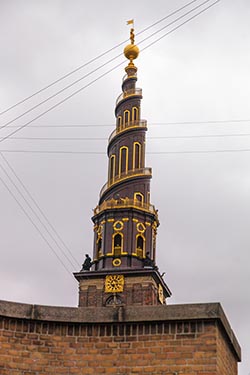 Though the castle is an impressive monument, its fame arose with William Shakespeare’s drama of Hamlet that takes place in the chambers of Kronborg. Today, Hamlet's spirit is still roaming the hallways of Kronborg, and every summer one can experience Hamlet perform the drama on an open air stage in the courtyard.
Though the castle is an impressive monument, its fame arose with William Shakespeare’s drama of Hamlet that takes place in the chambers of Kronborg. Today, Hamlet's spirit is still roaming the hallways of Kronborg, and every summer one can experience Hamlet perform the drama on an open air stage in the courtyard.
Due to its long history filled with royalty, myths and drama, Kronborg has become a UNESCO World Heritage Site. From Helsingor we drove to Hillerod for about 45 minutes that brought us to the gates of Frederiksborg Palace. This impressive Renaissance castle was built in the first decades of the 17th century by the Danish King Christian IV. Frederiksborg Castle has housed The Museum of National History since 1878, when it was established by brewer J.C. Jacobsen, the founder of Carlsberg. The beautiful decorated rooms with portraits, history paintings, furniture, and decorative art invite visitors on a journey through Danish history and culture from the late Middle Ages to the present. The historical interiors and the splendorous rooms give a sensuous impression of changing styles and epochs. The collection of portraits is the largest and most significant in Denmark, with new works continually added to the collection. 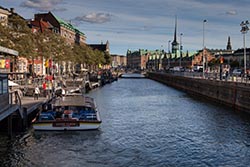 The Castle Gardens were laid out as a romantic landscaped garden. In the garden you will find King Frederik 2's small Bath House Castle (Badstueslot) which is occasionally used by the Royal Family for hunt lunches. The grounds also include the baroque style garden that was recreated in 1996 according to the original drawings by J.C. Krieger from 1725.
The Castle Gardens were laid out as a romantic landscaped garden. In the garden you will find King Frederik 2's small Bath House Castle (Badstueslot) which is occasionally used by the Royal Family for hunt lunches. The grounds also include the baroque style garden that was recreated in 1996 according to the original drawings by J.C. Krieger from 1725.
Post visit to the castle, we rushed through our lunch and drove back to Copenhagen. We made a brief photo stop at Rosenborg Palace and then proceeded to Amalienborg Palace Square. 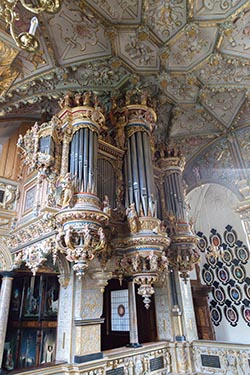 A royal hermitage set in the King’s Garden, the Rosenborg Castle features 400 years of splendor, royal art treasures and the Crown Jewels and Royal Regalia. Rosenborg Castle was built by one of the most famous Scandinavian kings, Christian IV, in the early 17th century.
A royal hermitage set in the King’s Garden, the Rosenborg Castle features 400 years of splendor, royal art treasures and the Crown Jewels and Royal Regalia. Rosenborg Castle was built by one of the most famous Scandinavian kings, Christian IV, in the early 17th century.
Among the main attractions is the Knights’ Hall with the coronation thrones and three life-size silver lions standing guard. Tapestries on the walls commemorate battles between Denmark and Sweden. The interiors are well-preserved and invite you to take a journey in time. You can experience the king’s private writing cabinet, his bathroom, and see wax figures of former royal inhabitants. Rosenborg also houses an exquisite collection of Flora Danica and one of the world’s finest Venetian glass collections, both set in tower chambers. The crowns of the Danish kings and queens are kept in special vaults and are embellished with table-cut stones, enamel and gold ornamentation. The crown jewels primarily consist of four garnitures: a diamond set, a ruby set, a pearl set, and an emerald set – the emeralds being among the world’s finest. 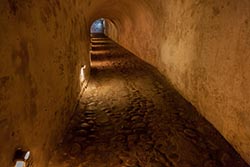 Amalienborg Palace is a feast for anyone with a taste for royal history and the life of Denmark’s royal family who still resides inside the palace.
Amalienborg Palace is a feast for anyone with a taste for royal history and the life of Denmark’s royal family who still resides inside the palace.
Amalienborg is famous for its Royal Guard, called Den Kongelige Livgarde. Every day you can experience the changing of the guards, as they march from their barracks in 100 Gothersgade by Rosenborg Castle through the streets of Copenhagen and end up at Amalienborg, where the changing of the guard takes place. Surrounding the palace square with its statue of King Frederik V from 1771, Amalienborg is made up of four identical buildings. These are Christian VII’s Palace (also known as Moltke's Palace, used as guest residence), Frederik VIII’s Palace (also known as Brockdorff’s Palace, home of the Crown Prince family), Christian IX’s Palace (also known as Schack’s Palace, home of the Queen) and Christian VIII’s Palace (also known as Levetzau' Palace, used as guest palace for Prince Joachim and Princess Benedikte). 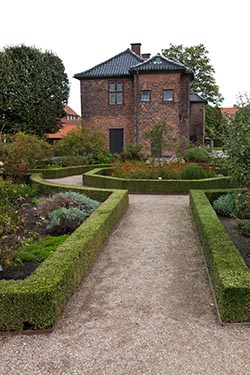 From the palace square one can't miss seeing the Marble Church. The awe inspiring Marble Church with the characteristic copper green dome has to be one of the most impressive churches of the city. The church lies beautifully in line with Amalienborg castle and The Opera in the middle of the elegant area of Frederiksstaden. In fact the official name of the church is Frederik's Church.
From the palace square one can't miss seeing the Marble Church. The awe inspiring Marble Church with the characteristic copper green dome has to be one of the most impressive churches of the city. The church lies beautifully in line with Amalienborg castle and The Opera in the middle of the elegant area of Frederiksstaden. In fact the official name of the church is Frederik's Church.
The Marble Church has an interesting story. Presided by King Frederik V the foundation stone was laid in 1749 as part of a grand plan of making a new city district called Frederiksstaden. The architect Nicolai Eigtved died in 1754 and the French architect Jardin continued the building after a revised drawing. The work now proceeded at snail's pace and owing to a squeeze in the funding the completion of the building was postponed several times. The building was not resumed until late 1800's for the church to be finally inaugurated in 1894. 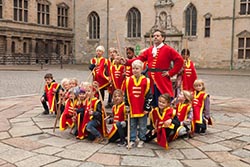 A 15-minute walk from the palace square and we were at the post-card perfect location – Nyhavn.
A 15-minute walk from the palace square and we were at the post-card perfect location – Nyhavn.
Nyhavn is an ideal place to end a long day. With a cold one on the quay like the locals, or at one of the many restaurants. Originally, Nyhavn was a busy commercial port where ships from all over the world would dock. The area was packed with sailors, ladies of pleasure, pubs and alehouses. Today the beautiful old houses have been renovated and restaurants dominate the old port. Nyhavn is filled with people enjoying the relaxed atmosphere by the canal, jazz music and great food. 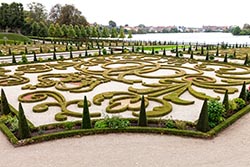 The famous Danish fairytale writer, Hans Christian Andersen, used to live in no. 20. This is where he wrote the fairy-tales 'The Tinderbox', 'Little Claus and Big Claus', and 'The Princess and the Pea'. He also lived twenty years in no. 67 and two years in no. 18.
The famous Danish fairytale writer, Hans Christian Andersen, used to live in no. 20. This is where he wrote the fairy-tales 'The Tinderbox', 'Little Claus and Big Claus', and 'The Princess and the Pea'. He also lived twenty years in no. 67 and two years in no. 18.
We were booked for an hour on the canal tour that would leave Nyhavn at 5. With some time on hand before boarding, I walked around the colourful waterfront and grabbed a coffee. On the boat we could glide along the city’s picturesque canals and harbour waters, and soak up stellar views of top Copenhagen attractions. Pass landmarks such as the Amalienborg Palace, the Little Mermaid statue and stunning Copenhagen Opera House; the Parliament, the Stock Exchange Building and drift around the canals of the Christianshavn neighborhood past colorful townhouses, cobbled lanes and houseboats. 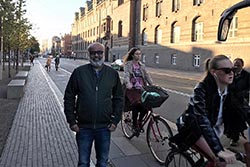 The Little Mermaid, you won't see a picture in here, simply because I couldn't take one! Though our boat was near the statue, the crowd around the mermaid did not make for a good sight! By the way, the Little Mermaid, in my frank opinion, is highly hyped... efficient marketing at work. The countless post-cards of the Little Mermaid, with beautiful different backgrounds, that one gets to see, honestly is not actually there. So be it.
The Little Mermaid, you won't see a picture in here, simply because I couldn't take one! Though our boat was near the statue, the crowd around the mermaid did not make for a good sight! By the way, the Little Mermaid, in my frank opinion, is highly hyped... efficient marketing at work. The countless post-cards of the Little Mermaid, with beautiful different backgrounds, that one gets to see, honestly is not actually there. So be it.
At 6, the bus was waiting for us at the boat pier that would drop us back to our hotel. For dinner, I opted for some Danish food. The next morning, post breakfast, we would leave for the airport to board our flight to Kangerlussuaq, Greenland. Copenhagen Image Gallery  Photo viewer Photo viewer
|
|
|
Home |
Charity |
Feedback
Privacy Policy | Terms of Usage © YoGoYo.com. All rights reserved. |































































































